BA-Walking-Tours.com
Buenos Aires Walking Tours
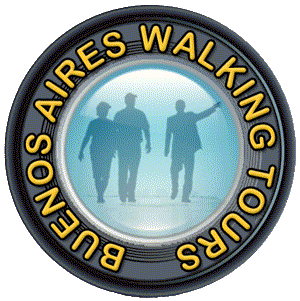
|
Private-Buenos-Aires-Tours.com
BA-Walking-Tours.com Buenos Aires Walking Tours |

|
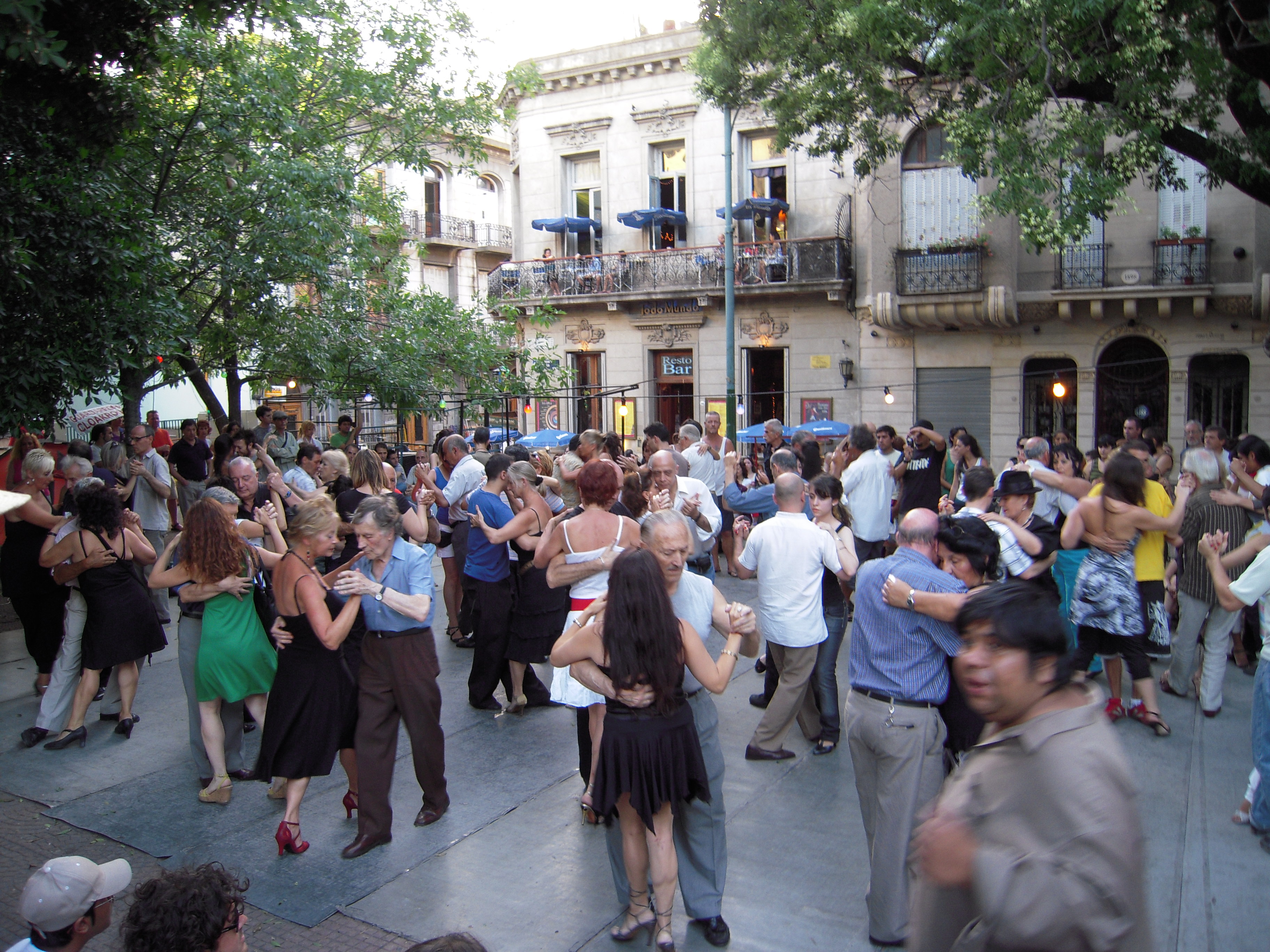
|
| Tango in San Telmo |
Book Now
• Description: Scroll (way) down for extensive information about BA-in-a-Day Tour of Buenos Aires!
• When: Start 10am, daily 365 days/year, rain or shine (Start earlier/later? Ask us!)
• Duration: approx. 6-7 hours (10am to 1pm, then a light-lunch intermission with your choice of lunch --cost not included-- at some typical local place (usually famous La Biela Café at Recoleta) and then we continue walking from 2pm to 5pm approx.)
• Price: Price for 2 people, $180 each. Click 'Book Now' for single-walker and small-groups. Contact us for large group pricing. NOTE: To add/include picturesque La Boca make sure you slelect that option on 'Book Now'!
• Discounts: Discounts available for large groups
• Meet: Hotel pickup is available at downtown hotels for a small additional fee (USD $20) depending on availability, if you let us know with at least 24hs advance advise. Otherwise your guide will wait for you at the door, outside the 'Florida Garden' cafe, corner of 899 Florida St (with Paraguay St) on the main pedestrian street, downtown, holding a small 'BA-Walking-Tours' sign. Get printable, bilingual ('good-for-taxi' or asking) directions here, or see map here.
• Note: This is a fun & comprehensive walking tour in English. It was specifically designed by our guides for savvy travelers with little time or tight agendas. It includes over 75 main city landmarks and lots of stories and explanations as well as off-the-beaten-track portions of the Historical Downtown, Recoleta, Palermo, Barrio Norte and La Boca neighbourhoods (La Boca is only offered as optional depending on your guide's availability and not included in the BA-in-a-Day Walk).
This is the tour to get some insight into local life, to learn about our local food, to see what the locals do and to have an authentic local cultural experience”.
With this tour combination you will be able to leave the city with the feeling that you have fully experienced Buenos Aires.
After this enjoyable Day Tour of Buenos Aires walk you will understand Buenos Aires (and Argentina!!) much better. It includes over 75 main city landmarks, and though it is not a strenuous walk, it is a long one: to see all these landmarks we do need to keep a quick pace--or cover a bit less: you decide. Full itinerary will be covered depending on time and circumstances at time of tour. We'll stop for coffee, snacks or refreshments along the walk, at emblematic cafes of cultural or historical value. Snacks, drinks, hotel pickup, transportation, foot massage, mid-life-counseling, good sense of humour and gratuities are not included (actually massage, counseling and good sense of humour are not even available!).
• Some key sights:
Note: If you want to wrap-up your experience of all that is relevant to BA in just one day, you can also book our 'Tango Night Out' as well for that night, and relax enjoying a superb, typical Tango dinner-show.
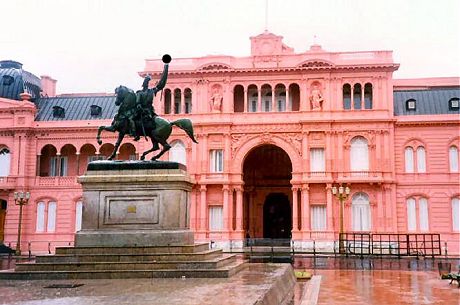 The Plaza de Mayo (Spanish: May Square) is the main historical square in downtown Buenos Aires, Argentina; it is flanked by Hipólito Yrigoyen, Balcarce, Rivadavia and Bolívar streets. Several of the city's major landmarks are located around the Plaza: the Cabildo (the city council during the colonial era), the Casa Rosada (home of the executive branch of the federal government), the Metropolitan Cathedral of Buenos Aires, the current city hall or municipalidad, and the headquarters of the Nación (National) Bank. (top...)
The Plaza de Mayo (Spanish: May Square) is the main historical square in downtown Buenos Aires, Argentina; it is flanked by Hipólito Yrigoyen, Balcarce, Rivadavia and Bolívar streets. Several of the city's major landmarks are located around the Plaza: the Cabildo (the city council during the colonial era), the Casa Rosada (home of the executive branch of the federal government), the Metropolitan Cathedral of Buenos Aires, the current city hall or municipalidad, and the headquarters of the Nación (National) Bank. (top...) On October 17, 1945, mass demonstrations in the Plaza de Mayo organised by the CGT (trade union federation) forced the release from prison of Juan Domingo Perón, who would later become president of Argentina. For several years the Peronist movement gathered every October 17th in the Plaza de Mayo to show their support for their leader (and October 17 is still "Loyalty Day" for the traditional Peronists). Many other presidents, both democratic and military, have also saluted people in the Plaza from the balcony of the Casa Rosada. (top...)
On October 17, 1945, mass demonstrations in the Plaza de Mayo organised by the CGT (trade union federation) forced the release from prison of Juan Domingo Perón, who would later become president of Argentina. For several years the Peronist movement gathered every October 17th in the Plaza de Mayo to show their support for their leader (and October 17 is still "Loyalty Day" for the traditional Peronists). Many other presidents, both democratic and military, have also saluted people in the Plaza from the balcony of the Casa Rosada. (top...)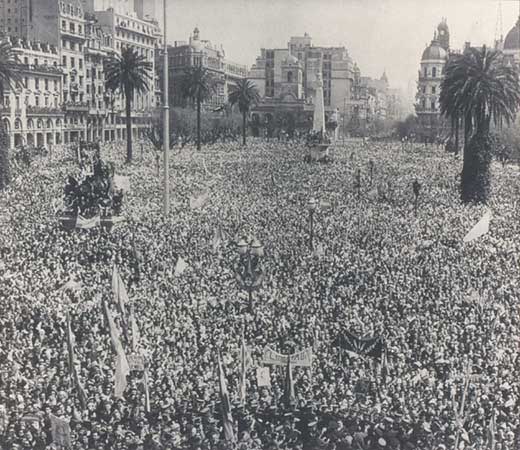 Crowds gathered once again on April 2, 1982 to hail de facto President Leopoldo Galtieri for starting the Falklands/Malvinas war. Since the late 1970s, this is where the Mothers of the Plaza de Mayo have congregated with signs and pictures of desaparecidos, their children, who disappeared (murdered) by the Argentine military in the Dirty War, during the National Reorganization Process. The Argentine military was anti-Communist, and people perceived to be supportive of such ideas would be illegally detained, subject to abuse and torture, and finally murdered in secret. (top...)
Crowds gathered once again on April 2, 1982 to hail de facto President Leopoldo Galtieri for starting the Falklands/Malvinas war. Since the late 1970s, this is where the Mothers of the Plaza de Mayo have congregated with signs and pictures of desaparecidos, their children, who disappeared (murdered) by the Argentine military in the Dirty War, during the National Reorganization Process. The Argentine military was anti-Communist, and people perceived to be supportive of such ideas would be illegally detained, subject to abuse and torture, and finally murdered in secret. (top...) Next we visit the birthplace of the University of Buenos Aires (the 'Manzana de las Luces' or 'Enlightment Square') and we continue our walk visiting some of the most ancient buildings still standing in Buenos Aires. Later, as we start to walk towards the famous (and very old) San Telmo neighbourhood, we learn about the why & how of the early British invasions to Buenos Aires (1806 & 1807) and we walk to the Basilica of Santo Domingo, where the British where finally cornered (you can still see cannonballs incrusted in the towers). Completed in 1783, this church housed the Natural History Museum and astronomic observatory under President Rivadavia. In 1835, the dictator Juan Manuel de Rosas repatriated the Dominicans friars and in 1856 the second tower was built. An atrium houses the Mausoleum of Gral. Manuel Belgrano (the creator of the Argentine flag, who was born and died near the church). This work by Hector Ximenez (1903) has a large base of red granite with two bas-reliefs representing the presentation of the Flag and the Battle of Tucuman.
(top...)
Next we visit the birthplace of the University of Buenos Aires (the 'Manzana de las Luces' or 'Enlightment Square') and we continue our walk visiting some of the most ancient buildings still standing in Buenos Aires. Later, as we start to walk towards the famous (and very old) San Telmo neighbourhood, we learn about the why & how of the early British invasions to Buenos Aires (1806 & 1807) and we walk to the Basilica of Santo Domingo, where the British where finally cornered (you can still see cannonballs incrusted in the towers). Completed in 1783, this church housed the Natural History Museum and astronomic observatory under President Rivadavia. In 1835, the dictator Juan Manuel de Rosas repatriated the Dominicans friars and in 1856 the second tower was built. An atrium houses the Mausoleum of Gral. Manuel Belgrano (the creator of the Argentine flag, who was born and died near the church). This work by Hector Ximenez (1903) has a large base of red granite with two bas-reliefs representing the presentation of the Flag and the Battle of Tucuman.
(top...) As we continue southwards we visit the house where Viceroy Liniers lived (he was considered a hero in 1807 when he defeated the British and executed as a traitor when he opposed the declaration of independence from Spain). We learn about early architecture in the colonies and its evollution, and start visiting the many wonders San Telmo has to offer: fascinating houses, antique stores, the old indoors market, the outdoors one (Plaza Dorrego) where Independence was sworn, and the chuch that gave origin to the neighbourhood's name.
(top...)
As we continue southwards we visit the house where Viceroy Liniers lived (he was considered a hero in 1807 when he defeated the British and executed as a traitor when he opposed the declaration of independence from Spain). We learn about early architecture in the colonies and its evollution, and start visiting the many wonders San Telmo has to offer: fascinating houses, antique stores, the old indoors market, the outdoors one (Plaza Dorrego) where Independence was sworn, and the chuch that gave origin to the neighbourhood's name.
(top...)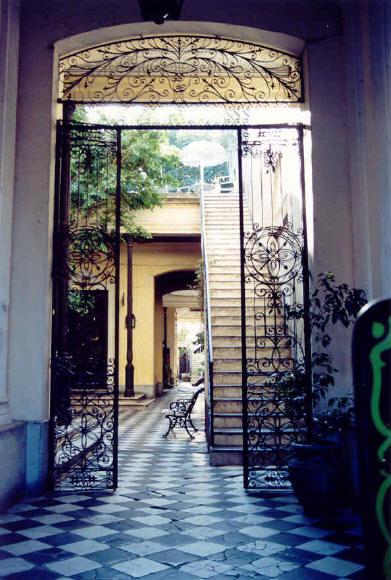 The neighborhood of La Boca (Note that La Boca is only offered as optional (ask us) and not included in the BA-in-a-Day Walk) is a spot that every Buenos Aires traveler should experience. There is a reason that so many tourists make La Boca a priority on their itinerary, and once you are there you will soon be overwhelmed by its charm and understand exactly why.
(top...)
The neighborhood of La Boca (Note that La Boca is only offered as optional (ask us) and not included in the BA-in-a-Day Walk) is a spot that every Buenos Aires traveler should experience. There is a reason that so many tourists make La Boca a priority on their itinerary, and once you are there you will soon be overwhelmed by its charm and understand exactly why.
(top...) Caminito is the main street of the area that is typically full of color, tango dancers, artists, and tourists with an excited trigger finger on their camera. The local artists spread their works of art across the streets to fill the lively outdoor market with displays and all kinds of fun. Each small door you pass opens up to an exciting world inside that offers every type of souvenir imaginable. On the weekends there is also the Feria de la Ribera, an arts and crafts market, set up outside.
(top...)
Caminito is the main street of the area that is typically full of color, tango dancers, artists, and tourists with an excited trigger finger on their camera. The local artists spread their works of art across the streets to fill the lively outdoor market with displays and all kinds of fun. Each small door you pass opens up to an exciting world inside that offers every type of souvenir imaginable. On the weekends there is also the Feria de la Ribera, an arts and crafts market, set up outside.
(top...)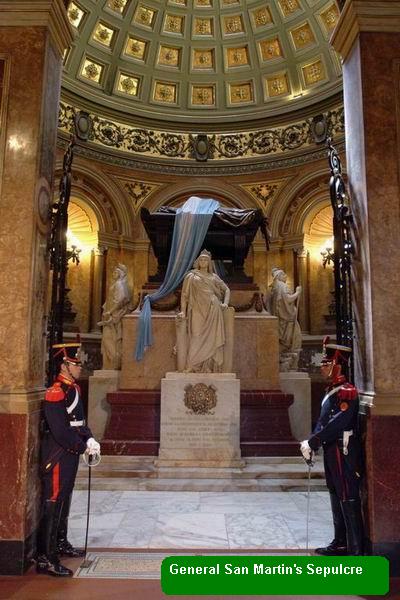 So you found the market, Caminito, the art work, some grub, and so now what? The Boca Juniors Futbol Stadium! If you have arrived on a game day, you will know. The futbol spirit is contagious and watching a game in Argentina is unlike any experience you will ever have. As the die hard fans wave their flags and yell out their Boca Juniors chants you will be amazed by the enthusiasm of the locals.
(top...)
So you found the market, Caminito, the art work, some grub, and so now what? The Boca Juniors Futbol Stadium! If you have arrived on a game day, you will know. The futbol spirit is contagious and watching a game in Argentina is unlike any experience you will ever have. As the die hard fans wave their flags and yell out their Boca Juniors chants you will be amazed by the enthusiasm of the locals.
(top...) As we walk towards Plaza San Martin Park, we see the footprint of the old bullfight arena which also doubled as a fort to defend the city. Next, we walk by the Plaza Hotel, built in 1909 by the german architect Alfred Zucker (he also built St. Patrick's cathedral in NY!!), this hotel (now run by the Marriot chain) hosted guests such as the Royal families of Spain, Belgium and Norway, Charles de Gaulle, Indira Ghandi, Nobel Prize Jonas Salk (of Polio vaccine fame), Nat King Cole, Nelson Rockefeller and many others.
(top...)
As we walk towards Plaza San Martin Park, we see the footprint of the old bullfight arena which also doubled as a fort to defend the city. Next, we walk by the Plaza Hotel, built in 1909 by the german architect Alfred Zucker (he also built St. Patrick's cathedral in NY!!), this hotel (now run by the Marriot chain) hosted guests such as the Royal families of Spain, Belgium and Norway, Charles de Gaulle, Indira Ghandi, Nobel Prize Jonas Salk (of Polio vaccine fame), Nat King Cole, Nelson Rockefeller and many others.
(top...) This very beautiful romanic-neogothic church (ca. 1915), which though very large looks dwarfed by the neighbouring Kavanagh and Plaza Hotel Buildings, is considered to be an architectural jewel. Designed by french architects, it is composed of 5 towers (3 in the front) with beautiful white marble sculptures in its front. Inside it you can find beautiful wood carvings made by Flemish artisans (from Brugge, Belgium) and 2 world renowned organs which master organ players from around the world come to play and listen to (one is a 4800 pipe Mutin-Cavaillé-Coll from France and the other a Merklin from Belgium, similar, but slightly smaller than the ones in Notre-Dame Cathedral and Sacre Coeur in Paris). Four meters below the base of the belfry is the cript of Mrs. Mercedes Castellanos de Anchorena who had this whole massive church built for her (as a cript for her family) between 1907 and 1915: She was inmensely rich and we will later see her family palace-like mansion, just across the Plaza San Martin park. It sets the tone for understanding the mindset of the families that shaped Buenos Aires.
(top...)
This very beautiful romanic-neogothic church (ca. 1915), which though very large looks dwarfed by the neighbouring Kavanagh and Plaza Hotel Buildings, is considered to be an architectural jewel. Designed by french architects, it is composed of 5 towers (3 in the front) with beautiful white marble sculptures in its front. Inside it you can find beautiful wood carvings made by Flemish artisans (from Brugge, Belgium) and 2 world renowned organs which master organ players from around the world come to play and listen to (one is a 4800 pipe Mutin-Cavaillé-Coll from France and the other a Merklin from Belgium, similar, but slightly smaller than the ones in Notre-Dame Cathedral and Sacre Coeur in Paris). Four meters below the base of the belfry is the cript of Mrs. Mercedes Castellanos de Anchorena who had this whole massive church built for her (as a cript for her family) between 1907 and 1915: She was inmensely rich and we will later see her family palace-like mansion, just across the Plaza San Martin park. It sets the tone for understanding the mindset of the families that shaped Buenos Aires.
(top...)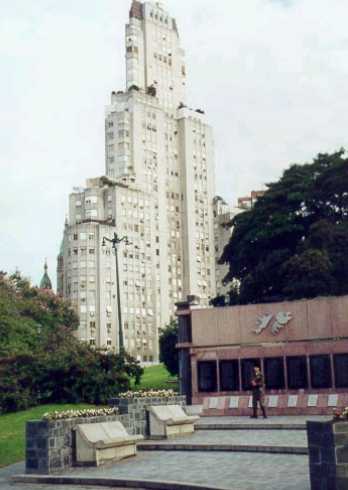 Let us now go back to the Kavanagh Building. It was built by architects Sanchez, Lagos and De la Torre for Corinna Kavanagh, a then 39 year old eccentric heiress of Irish ancestry who talked her father into building this huge skyscraper so she would have some comfortable rental income (actually 113 expensive rental units) to care for her future. It is on the records that to be able to complete the construction of this luxurious and groundbreaking rationalist (art Deco) building (at 36 stories, 13 elevators and 120 meters high, the tallest in South America at the time it was built, and the first building in the world with central air conditioning) she sold her two large "estancias" (estate ranches). She must be credited as a visionaire, for the building that is built over a slope, offers very luxurious appartments (the smallest is 1400 sq. ft.) with a common pattern which includes terrace gardens (see some trees halfways up there in the photo?) in one third of its still-very-coveted 113 units. Finally, she was forced (during President Peron's mandate) to sell all units, which she did along 16 years. Those who now own these very exclusive appartments (many are notorious politicians and tycoons) do not pay taxes, since the building was declared of UNESCO's interest in 1999 and are since tax exempt. Amongst other distinctions, in 1939 the building shared a technical award of the the American Society of Engineers together with the Eiffel Tower, the Aswan Dam and the Panama Canal.
(top...)
Let us now go back to the Kavanagh Building. It was built by architects Sanchez, Lagos and De la Torre for Corinna Kavanagh, a then 39 year old eccentric heiress of Irish ancestry who talked her father into building this huge skyscraper so she would have some comfortable rental income (actually 113 expensive rental units) to care for her future. It is on the records that to be able to complete the construction of this luxurious and groundbreaking rationalist (art Deco) building (at 36 stories, 13 elevators and 120 meters high, the tallest in South America at the time it was built, and the first building in the world with central air conditioning) she sold her two large "estancias" (estate ranches). She must be credited as a visionaire, for the building that is built over a slope, offers very luxurious appartments (the smallest is 1400 sq. ft.) with a common pattern which includes terrace gardens (see some trees halfways up there in the photo?) in one third of its still-very-coveted 113 units. Finally, she was forced (during President Peron's mandate) to sell all units, which she did along 16 years. Those who now own these very exclusive appartments (many are notorious politicians and tycoons) do not pay taxes, since the building was declared of UNESCO's interest in 1999 and are since tax exempt. Amongst other distinctions, in 1939 the building shared a technical award of the the American Society of Engineers together with the Eiffel Tower, the Aswan Dam and the Panama Canal.
(top...)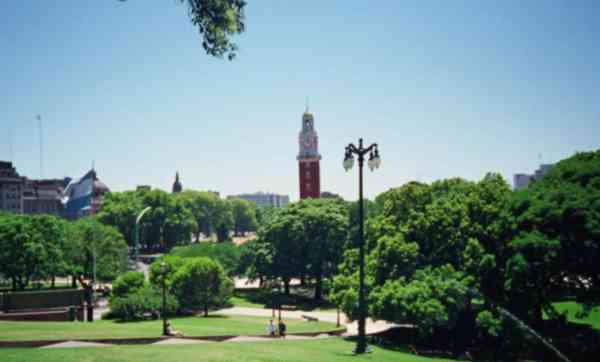 After Plaza de Mayo, our next most important "Plaza" (park) from an historical point of view is Plaza San Martin, because it is here that the patriots fought and resisted the English invasion of 1807. Until 1819, Plaza San Martin was the Plaza de Toros (the bullfight ring) and part of this park still keeps that ancient footprint (the circular shape along Av. Santa Fe is due to that architectural fact).
(top...)
After Plaza de Mayo, our next most important "Plaza" (park) from an historical point of view is Plaza San Martin, because it is here that the patriots fought and resisted the English invasion of 1807. Until 1819, Plaza San Martin was the Plaza de Toros (the bullfight ring) and part of this park still keeps that ancient footprint (the circular shape along Av. Santa Fe is due to that architectural fact).
(top...)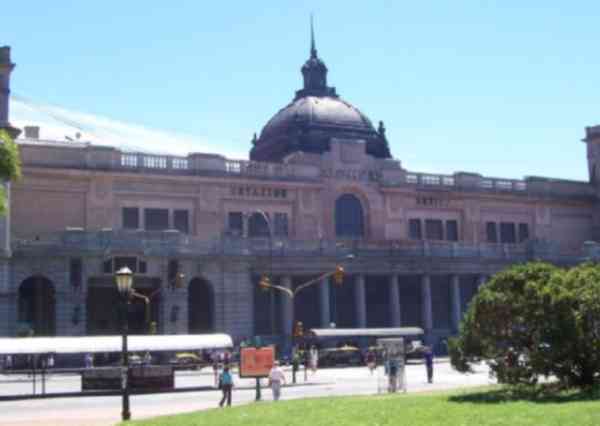 The monument to those fallen in the Malvinas (Falkland) war (1982), ironically it is placed just across the British tower (donated by the UK in 1916), now called Monumental Tower. Since 1880, there had been a growth explosion in this area. The city became the capital as a consequence of Buenos Aires Federation. Railways grew and the port acquired a decisive importance both for commerce and to receive 3,300,000 immigrants in just three decades (1880-1914). During this period, public and private buildings were put up, parks and monuments radically changed the city profile. The new urban design highlights the europeization as essential part of the project of the governing class from the end of the XIXth. century.
(top...)
The monument to those fallen in the Malvinas (Falkland) war (1982), ironically it is placed just across the British tower (donated by the UK in 1916), now called Monumental Tower. Since 1880, there had been a growth explosion in this area. The city became the capital as a consequence of Buenos Aires Federation. Railways grew and the port acquired a decisive importance both for commerce and to receive 3,300,000 immigrants in just three decades (1880-1914). During this period, public and private buildings were put up, parks and monuments radically changed the city profile. The new urban design highlights the europeization as essential part of the project of the governing class from the end of the XIXth. century.
(top...) The train stations (and the railways) where built and run by the English, and are built on land gained to the river. The oldest is the farthest one from our viewpoint and it is called San Martin (1886), because these tracks lead across the country to Mendoza and the Andes (the route San Martin followed). The one in the middle is called General Belgrano, because it follows the route to the territories where this General's campaigns took place towards the center and north of our country (Córdoba Province, etc.), and same thing with the first and largest station General Mitre whose farthest tracks go south to Bariloche (in Patagonia) and beyond. By the way, the name Retiro (retiro=to withdraw, be alone) comes from the fact this area was initially in the early 1700's given to the San Sebastián monastery where spiritual seclusion was performed.
(top...)
The train stations (and the railways) where built and run by the English, and are built on land gained to the river. The oldest is the farthest one from our viewpoint and it is called San Martin (1886), because these tracks lead across the country to Mendoza and the Andes (the route San Martin followed). The one in the middle is called General Belgrano, because it follows the route to the territories where this General's campaigns took place towards the center and north of our country (Córdoba Province, etc.), and same thing with the first and largest station General Mitre whose farthest tracks go south to Bariloche (in Patagonia) and beyond. By the way, the name Retiro (retiro=to withdraw, be alone) comes from the fact this area was initially in the early 1700's given to the San Sebastián monastery where spiritual seclusion was performed.
(top...) Upon his arrival in Buenos Aires in March 1812, he was given the task of organizing an armed force to be used against the Spanish royalists in Peru. He married Maria de los Remedios Escalada in September, 1812. Maria came from an Argentine upper-class family of Spanish blood. He became more involved in internal politics of the area by helping to form the "Lautaro Lodge", which was an underground movement which later aligned itself with the opposition to the government that was in power. In February 3, 1813, San Martin entered his first battle in South America, and managed to defeat a royalist force that came up the "Parana River". In the middle of 1814, he had to briefly retire because of weakening health. He believed that the best way to accomplish his plans was to enter Peru through the mountains of Upper Peru. This was the most direct way, but also the most difficult, due to the physical structure of the Andes. Another, a perhaps more promising route would be to move towards the west, from Argentina to Chile, and by sea to the "Peruvian coast". San Martin started to prepare his plans, and by asking for reassignment to the governor-ship of Cuyo, which was located at the foot of the Andes in western Argentina, he was able to design his plans.
(top...)
Upon his arrival in Buenos Aires in March 1812, he was given the task of organizing an armed force to be used against the Spanish royalists in Peru. He married Maria de los Remedios Escalada in September, 1812. Maria came from an Argentine upper-class family of Spanish blood. He became more involved in internal politics of the area by helping to form the "Lautaro Lodge", which was an underground movement which later aligned itself with the opposition to the government that was in power. In February 3, 1813, San Martin entered his first battle in South America, and managed to defeat a royalist force that came up the "Parana River". In the middle of 1814, he had to briefly retire because of weakening health. He believed that the best way to accomplish his plans was to enter Peru through the mountains of Upper Peru. This was the most direct way, but also the most difficult, due to the physical structure of the Andes. Another, a perhaps more promising route would be to move towards the west, from Argentina to Chile, and by sea to the "Peruvian coast". San Martin started to prepare his plans, and by asking for reassignment to the governor-ship of Cuyo, which was located at the foot of the Andes in western Argentina, he was able to design his plans.
(top...) As we move on across the Plaza San Martin we can see two Palaces: the smaller one with triangluar footprint belonged to the Haedo family and is now site to the National Park Administration entity. It was built in the 1880's, being amongst the first in the upcoming elegant neighbourhood but was then dwarved by the neighbouring mansions, like the magnificent one which is now the social headquarters for the military. It was built in the 1900's by the rich landlord and newspaper owner Jose C. Paz (he founded "La Prensa" newspaper, a major player until not long ago, whose magnificent building you can view near Plaza de Mayo). The palace was totally designed and imported from France and took 12 years to complete. Mr. Paz' goals were not only a beautiful house, but one that would be suitable for a Presidential Palace, as he was running for president, but unfortunately he died a year before its completion. His widow and two children enjoyed this magnificent versaillesque palace, full of marble, silk, wood carvings and boiseries till 1939 when it was sold to the military. It also hosts the interesting and quite complete National Museum of Arms with weapons of all ages, including a thorough oriental / Japanese arms collection.
(top...)
As we move on across the Plaza San Martin we can see two Palaces: the smaller one with triangluar footprint belonged to the Haedo family and is now site to the National Park Administration entity. It was built in the 1880's, being amongst the first in the upcoming elegant neighbourhood but was then dwarved by the neighbouring mansions, like the magnificent one which is now the social headquarters for the military. It was built in the 1900's by the rich landlord and newspaper owner Jose C. Paz (he founded "La Prensa" newspaper, a major player until not long ago, whose magnificent building you can view near Plaza de Mayo). The palace was totally designed and imported from France and took 12 years to complete. Mr. Paz' goals were not only a beautiful house, but one that would be suitable for a Presidential Palace, as he was running for president, but unfortunately he died a year before its completion. His widow and two children enjoyed this magnificent versaillesque palace, full of marble, silk, wood carvings and boiseries till 1939 when it was sold to the military. It also hosts the interesting and quite complete National Museum of Arms with weapons of all ages, including a thorough oriental / Japanese arms collection.
(top...)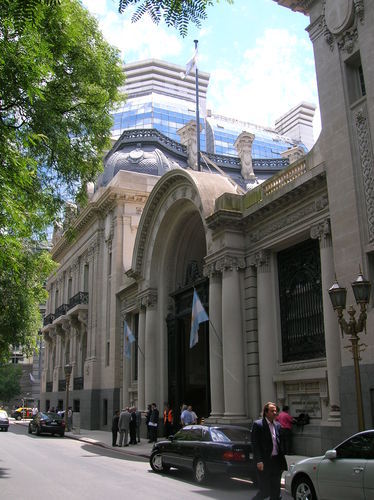 By now we should be standing in front of the Anchorena Palace (now called Palacio San Martin and used for the Ministry of External Affairs). Anchorena Palace was built in 1906 by Alejandro Cristophersen ( 1866-1946). It is a unique complex of three private houses, (the floor plans are harmonized and there are two common rooms, yet basically no house repeats features of the two others), their construction was inspired in French neo-classic architecture of the XVIII th. century. It originally belonged to Anchorena family, built on the very heart of the most elegant residential area between 1906 and 1909 by architect Alejandro Christophersen, who was commissioned by Mrs. Mercedes Castellanos de Anchorena and her two sons, Aaron and Emilio. It is a single building containing three separate residences encircling a large central patio. Its structure brings together elements from French academicism and from the Borbonic style. Major features are the iron and glass balcony overlooking Basavilbaso Street, and the façade's iron gates, highlighting the importance of the residence from its access point. The Anchorena Palace was the setting for major social events, such as the Ball held for the Independence Centennial in 1916. In 1936, it was purchased by the Argentine State to become the headquarters of the Ministry of Foreign Relations. Nowadays, it has become the protocol quarters of the Ministry, since the offices have been moved to the new building in Arenales and Esmeralda, built by architects Aizenstat and Rajlin, whose architecture seems to converse with the monumental masterpiece by Christophersen. The San Martin Palace is a national historic monument and holds a vast library specializing in international law and the history of international relations. It stands as a valuable testimony of the heights reached by French classicism architecture and by the adaptation of certain kinds of 18-century French residences to the local media. The Anchorenas would have had a direct view of the magnificent church Mercedes Anchorena had built, not far across the park, amidst her wealthy neighbours palaces, had it not been for Corinna Kavanagh's mix of revenge, whim and daring vision.
(top...)
By now we should be standing in front of the Anchorena Palace (now called Palacio San Martin and used for the Ministry of External Affairs). Anchorena Palace was built in 1906 by Alejandro Cristophersen ( 1866-1946). It is a unique complex of three private houses, (the floor plans are harmonized and there are two common rooms, yet basically no house repeats features of the two others), their construction was inspired in French neo-classic architecture of the XVIII th. century. It originally belonged to Anchorena family, built on the very heart of the most elegant residential area between 1906 and 1909 by architect Alejandro Christophersen, who was commissioned by Mrs. Mercedes Castellanos de Anchorena and her two sons, Aaron and Emilio. It is a single building containing three separate residences encircling a large central patio. Its structure brings together elements from French academicism and from the Borbonic style. Major features are the iron and glass balcony overlooking Basavilbaso Street, and the façade's iron gates, highlighting the importance of the residence from its access point. The Anchorena Palace was the setting for major social events, such as the Ball held for the Independence Centennial in 1916. In 1936, it was purchased by the Argentine State to become the headquarters of the Ministry of Foreign Relations. Nowadays, it has become the protocol quarters of the Ministry, since the offices have been moved to the new building in Arenales and Esmeralda, built by architects Aizenstat and Rajlin, whose architecture seems to converse with the monumental masterpiece by Christophersen. The San Martin Palace is a national historic monument and holds a vast library specializing in international law and the history of international relations. It stands as a valuable testimony of the heights reached by French classicism architecture and by the adaptation of certain kinds of 18-century French residences to the local media. The Anchorenas would have had a direct view of the magnificent church Mercedes Anchorena had built, not far across the park, amidst her wealthy neighbours palaces, had it not been for Corinna Kavanagh's mix of revenge, whim and daring vision.
(top...) Now we walk down to Arroyo St., but first we glance at the large Strugamou Palace (1924). In this case it is not really a palace but a strata building, though it is nicknamed this way because of its beauty and quality. Arroyo St. has an european flair to it because of the style of its buildings and because it is a rather narrow, winding street as opposed to the rest of the city. It is lined with art galleries and expensive antique shops, and once a month the whole street is closed to traffic, the street is filled with music, and art galleries offer champagne and hors-de-oeuvres to the public till late at night (usually the last friday of each month, except for January and February, in which most people who can leave the city for the holidays at the beaches). This monthly event is called "Gallery Nights". As we walk down Arroyo (brook) street, we should look up at the entrance of the Sofitel Hotel, and see the Mihanovich/Bencich Tower: the first freestanding (tower-like) building erected in BA (1920s) whose top imitates the tomb of greek King Mausolo (hence Mausoleum) built around bc377, now recycled into a fashionable Hotel.
(top...)
Now we walk down to Arroyo St., but first we glance at the large Strugamou Palace (1924). In this case it is not really a palace but a strata building, though it is nicknamed this way because of its beauty and quality. Arroyo St. has an european flair to it because of the style of its buildings and because it is a rather narrow, winding street as opposed to the rest of the city. It is lined with art galleries and expensive antique shops, and once a month the whole street is closed to traffic, the street is filled with music, and art galleries offer champagne and hors-de-oeuvres to the public till late at night (usually the last friday of each month, except for January and February, in which most people who can leave the city for the holidays at the beaches). This monthly event is called "Gallery Nights". As we walk down Arroyo (brook) street, we should look up at the entrance of the Sofitel Hotel, and see the Mihanovich/Bencich Tower: the first freestanding (tower-like) building erected in BA (1920s) whose top imitates the tomb of greek King Mausolo (hence Mausoleum) built around bc377, now recycled into a fashionable Hotel.
(top...) At the end of the short Arroyo St. we find the impront on the wall, of what used to be a small peautiful palace-like building, demolished by a single bomb blast on the morning of March 17 1992: these are the remains of the embassy of Israel, where 22 people died. The naighbouring buildings were shattered to pieces and glass windows were broken around the block. The glass-covered high-rise building right across had to be evacuated and repaired and scaffolding was withdrawn only recently.
(top...)
At the end of the short Arroyo St. we find the impront on the wall, of what used to be a small peautiful palace-like building, demolished by a single bomb blast on the morning of March 17 1992: these are the remains of the embassy of Israel, where 22 people died. The naighbouring buildings were shattered to pieces and glass windows were broken around the block. The glass-covered high-rise building right across had to be evacuated and repaired and scaffolding was withdrawn only recently.
(top...) We now walk to the end of Carlos Pellegrini St. where we find a modern toll circular building and we walk under the highway across an area of high-quality restaurants and by the Hyatt hotel (the balcony you see wa used by Madonna when she rented two full floors of the hotel while she was filming the musical Evita in our town). A block away we see the awnings af the beautiful Patio Bullrich mall (a recicled old auctioneer's warehouse turned into an exclusive mall, with fashinable stores and 6 excellent cinemas and food-court open from 10am until well past midnight) as we pass across the Alzaga Unzué Palace, which is at the base of the Hyatt Hotel (this palace is considered National Heritage, so the hotel could only be built if the palace was preserved). A few meters more and we arrive at Alvear St., renowned for its palaces, embassies and expensive stores.
(top...)
We now walk to the end of Carlos Pellegrini St. where we find a modern toll circular building and we walk under the highway across an area of high-quality restaurants and by the Hyatt hotel (the balcony you see wa used by Madonna when she rented two full floors of the hotel while she was filming the musical Evita in our town). A block away we see the awnings af the beautiful Patio Bullrich mall (a recicled old auctioneer's warehouse turned into an exclusive mall, with fashinable stores and 6 excellent cinemas and food-court open from 10am until well past midnight) as we pass across the Alzaga Unzué Palace, which is at the base of the Hyatt Hotel (this palace is considered National Heritage, so the hotel could only be built if the palace was preserved). A few meters more and we arrive at Alvear St., renowned for its palaces, embassies and expensive stores.
(top...) The Dr. Arturo Illia highway we just walked under was one of the several megalomaniac monumental constructions developed under the recent military dictatorships, and though it may look like positive in some ways, they actually destroyed lots of beautiful heritage buildings and palaces for the relative benefit few cars use. Many people believe there were hidden interests in making those huge expenditures, but in the case of the beautiful Ortiz Basualdo Palace we were lucky. Built in 1912 by the french architect Mr. Pater, the Ortiz-Basualdos had some very important guests, like Edward Windsor, Prince of Wales (later King Edward the VIII) who stayed here during his 1925 visit to Argentina. The dining-room boiserie is a replica of the one in the royal castle of Oslo in Norway. In 1939 it was bought by the government of France to be used for their Embassy seat. When the military requested the French govt. to surrender the building to be demolished for the construction of the Illia highway, the french simply said no, as embassies are protected territory for life. At the door you will find a list of fifteen French citizens (including two nuns) who dissapeared during the recent military dictatorships.
(top...)
The Dr. Arturo Illia highway we just walked under was one of the several megalomaniac monumental constructions developed under the recent military dictatorships, and though it may look like positive in some ways, they actually destroyed lots of beautiful heritage buildings and palaces for the relative benefit few cars use. Many people believe there were hidden interests in making those huge expenditures, but in the case of the beautiful Ortiz Basualdo Palace we were lucky. Built in 1912 by the french architect Mr. Pater, the Ortiz-Basualdos had some very important guests, like Edward Windsor, Prince of Wales (later King Edward the VIII) who stayed here during his 1925 visit to Argentina. The dining-room boiserie is a replica of the one in the royal castle of Oslo in Norway. In 1939 it was bought by the government of France to be used for their Embassy seat. When the military requested the French govt. to surrender the building to be demolished for the construction of the Illia highway, the french simply said no, as embassies are protected territory for life. At the door you will find a list of fifteen French citizens (including two nuns) who dissapeared during the recent military dictatorships.
(top...)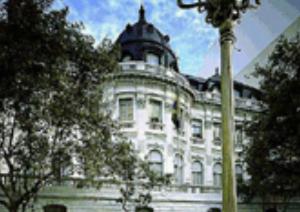 As we walk across the Cepeda Palace we will see (opposite) the Jockey Club of Buenos Aires, founded on 1882 by Argenitne President Dr. Carlos Pellegrini, (monument across the street) as a social center and as an institution that would seek to improve horse breeds. The institution should serve as a top level social center, paramount to the best European clubs these gentlemen had visited in their trips to France and England. The Pereda Palace, across the street was built in 1936 for Celedonio Pereda, a landowner who owned around 1928 some 122,000 hectares making him the fourth largest landowner in his time. His palace was full of works of art and had its own chapel. The house had 40,000 sq. ft. for the use of the family. The then Brazilian ambassador (and later president of Brasil) Dr. Getulio Vargas stayed there as a guest in 1938, and later bought the palace in 1944 to use it as Brasilian embassy.
(top...)
As we walk across the Cepeda Palace we will see (opposite) the Jockey Club of Buenos Aires, founded on 1882 by Argenitne President Dr. Carlos Pellegrini, (monument across the street) as a social center and as an institution that would seek to improve horse breeds. The institution should serve as a top level social center, paramount to the best European clubs these gentlemen had visited in their trips to France and England. The Pereda Palace, across the street was built in 1936 for Celedonio Pereda, a landowner who owned around 1928 some 122,000 hectares making him the fourth largest landowner in his time. His palace was full of works of art and had its own chapel. The house had 40,000 sq. ft. for the use of the family. The then Brazilian ambassador (and later president of Brasil) Dr. Getulio Vargas stayed there as a guest in 1938, and later bought the palace in 1944 to use it as Brasilian embassy.
(top...) Now we are back in Alvear street to see Hume Residence, Duhau Palace and Fernandez-Anchorena Mansion (now Vatican Embassy). The Duhau's neoclassic french residence was built in 1932 for the wealthy and aristocratic Duhau brothers, whilst the Hume/McGuire Residence is one of the first and oldest buildings in this old residential state area (1890). It is in this palace that the first private collection art exhibitions took place in BA. There were more palaces here when I was a boy (like the DeRidder Family one, which always had a live pair of sheep, one white and one black pasturing freely along the front garden!), but they have been turned into the large building at the back of the Caesars Park hotel which faces the Patio Bullrich mall on the opposite side of the block).
Now we are back in Alvear street to see Hume Residence, Duhau Palace and Fernandez-Anchorena Mansion (now Vatican Embassy). The Duhau's neoclassic french residence was built in 1932 for the wealthy and aristocratic Duhau brothers, whilst the Hume/McGuire Residence is one of the first and oldest buildings in this old residential state area (1890). It is in this palace that the first private collection art exhibitions took place in BA. There were more palaces here when I was a boy (like the DeRidder Family one, which always had a live pair of sheep, one white and one black pasturing freely along the front garden!), but they have been turned into the large building at the back of the Caesars Park hotel which faces the Patio Bullrich mall on the opposite side of the block). 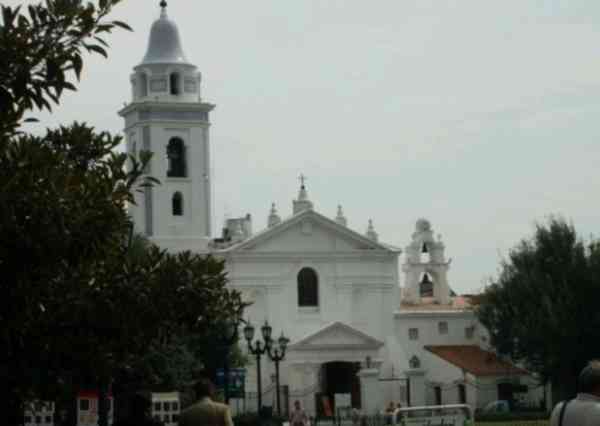 Let's move on along Alvear Av. and as we cross Callao Av. it is funny to realize this was once the city limit (now replaced by the Av. General Paz, ring road, almost 6 miles away, in this same direction). There are many nice shops in this neighbourhood too (this part of the Barrio Norte is currrently called Recoleta). Recoleta gets its name from the Convento of the Recoletos friars, who got their land from a couple of landowners (Don Fernando de Valdéz e Inclán and Doña Guerrero y Hurtado) who got it (they paid it with clothes!) from Don Rodrigo Ortíz de Zárate who was under the orders of Don Juan de Garay, the city's founder in 1537. Around 1725 Don Juan de Narvona offered to finance and complete the construction of the church, and he --a notorious businessman, developer and smuggler-- did that and more: he had himself built a 14 room mansion and a few tunnels under the church which led towards other points in the city and the river shore (this city was --and still is-- packed with colonial tunnels connecting Plaza de Mayo, Retiro, the churches and the river shore).
(top...)
Let's move on along Alvear Av. and as we cross Callao Av. it is funny to realize this was once the city limit (now replaced by the Av. General Paz, ring road, almost 6 miles away, in this same direction). There are many nice shops in this neighbourhood too (this part of the Barrio Norte is currrently called Recoleta). Recoleta gets its name from the Convento of the Recoletos friars, who got their land from a couple of landowners (Don Fernando de Valdéz e Inclán and Doña Guerrero y Hurtado) who got it (they paid it with clothes!) from Don Rodrigo Ortíz de Zárate who was under the orders of Don Juan de Garay, the city's founder in 1537. Around 1725 Don Juan de Narvona offered to finance and complete the construction of the church, and he --a notorious businessman, developer and smuggler-- did that and more: he had himself built a 14 room mansion and a few tunnels under the church which led towards other points in the city and the river shore (this city was --and still is-- packed with colonial tunnels connecting Plaza de Mayo, Retiro, the churches and the river shore).
(top...)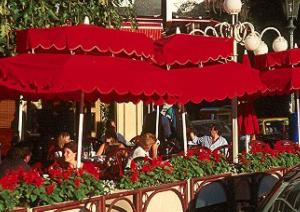 We walk one street (Ayacucho) to Quintana Av., and here we are approaching the core of Recoleta with its streetside cafés, its huge (60 mtr span) bicentenary gum trees, the Pilar church and its neighbouring posh-city-of-the-elegant-dead: The world famous Recoleta cemetery, where it is very hard to be accepted and Evita Perón is an unwanted illustrious parvenú (social upstart) sleeping forever amongst the people she hated --and hated her-- (we explain all about her story along the Afternoon Walk). Although it may seem unusual, the 4 acre cemetery area is also surrounded by elegant restaurants, bars, discos, outdoor shows, a cinema complex and even a great handicrafts fair that opens on weekends.
(top...)
We walk one street (Ayacucho) to Quintana Av., and here we are approaching the core of Recoleta with its streetside cafés, its huge (60 mtr span) bicentenary gum trees, the Pilar church and its neighbouring posh-city-of-the-elegant-dead: The world famous Recoleta cemetery, where it is very hard to be accepted and Evita Perón is an unwanted illustrious parvenú (social upstart) sleeping forever amongst the people she hated --and hated her-- (we explain all about her story along the Afternoon Walk). Although it may seem unusual, the 4 acre cemetery area is also surrounded by elegant restaurants, bars, discos, outdoor shows, a cinema complex and even a great handicrafts fair that opens on weekends.
(top...)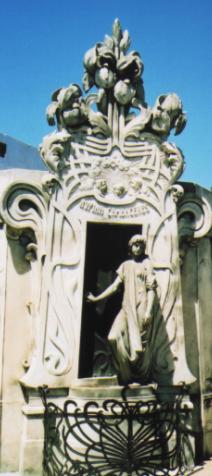 Every day, busloads of tourists visit the black granite tomb of Evita Peron at Recoleta Cemetery in Buenos Aires. They listen to a few words from their tour guide, snap pictures and move on, rarely stopping to appreciate the grandeur of one of the world's most significant graveyards.
Sitting on a four-block area of the city's most expensive real estate, the 183-year-old cemetery is in grave need of restoration.
Marble tombs are being eaten away by acid rain, and their stucco ornaments are also dissolving, exposing brick interiors. Some historically significant tombs are being destroyed by human hands, through neglect or modernization.
This is one of the five most important cemeteries in the world as Recoleta represents an important historical moment for the city of Buenos Aires (one ot the ten largest cities in the world) and how it was forming at the time.
(top...)
Every day, busloads of tourists visit the black granite tomb of Evita Peron at Recoleta Cemetery in Buenos Aires. They listen to a few words from their tour guide, snap pictures and move on, rarely stopping to appreciate the grandeur of one of the world's most significant graveyards.
Sitting on a four-block area of the city's most expensive real estate, the 183-year-old cemetery is in grave need of restoration.
Marble tombs are being eaten away by acid rain, and their stucco ornaments are also dissolving, exposing brick interiors. Some historically significant tombs are being destroyed by human hands, through neglect or modernization.
This is one of the five most important cemeteries in the world as Recoleta represents an important historical moment for the city of Buenos Aires (one ot the ten largest cities in the world) and how it was forming at the time.
(top...)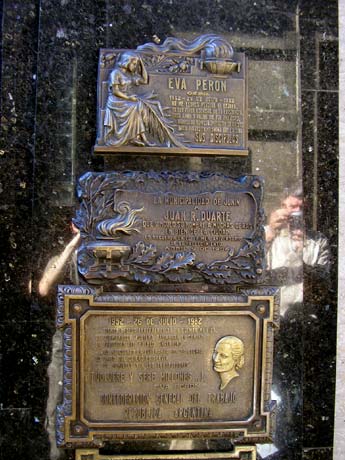 The labyrinthine necropolis is laid out like a town. There is no map and only one sign -- to Mausoleo Sarmiento, a soaring obelisk crowned with a condor. It commemorates the Argentine hero Domingo Faustino Sarmiento, President, writer and educator, who died Sept. 11, 1888. The predominant color is gray.
The entrance is post-colonial in style with four columns, a peristyle and tall wrought-iron gates. Just inside is the main avenue, an address of choice lined with cypress trees, stone benches and some 50 showpiece mausoleums. A towering bronze statue of El Redentor, The Redeemer, is in the center. Along the avenue visitors admire the white marble beauty of Luz Maria Garcia Velloso in a softly draped dress, lying asleep among sculptured roses on a white marble sarcophagus. A bronze ship atop a green column celebrates Adm. Guillermo Brown (an Irish adventurer/corsair who did well in Argentina), who gave ''days of glory and triumph in the year 1814.'' His neighbor, Gen. Tomas Guido, a friend and colleague of the great Libertador General San Martin, is buried in a little stone grotto.
(top...)
The labyrinthine necropolis is laid out like a town. There is no map and only one sign -- to Mausoleo Sarmiento, a soaring obelisk crowned with a condor. It commemorates the Argentine hero Domingo Faustino Sarmiento, President, writer and educator, who died Sept. 11, 1888. The predominant color is gray.
The entrance is post-colonial in style with four columns, a peristyle and tall wrought-iron gates. Just inside is the main avenue, an address of choice lined with cypress trees, stone benches and some 50 showpiece mausoleums. A towering bronze statue of El Redentor, The Redeemer, is in the center. Along the avenue visitors admire the white marble beauty of Luz Maria Garcia Velloso in a softly draped dress, lying asleep among sculptured roses on a white marble sarcophagus. A bronze ship atop a green column celebrates Adm. Guillermo Brown (an Irish adventurer/corsair who did well in Argentina), who gave ''days of glory and triumph in the year 1814.'' His neighbor, Gen. Tomas Guido, a friend and colleague of the great Libertador General San Martin, is buried in a little stone grotto.
(top...)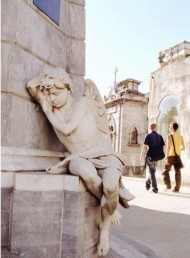 In every graveyard there is a story behind every grave. In Recoleta the stories are those of a nation, and there are some good ones. In 1828 Gen. Juan Lavalle ordered the execution of Gen. Manuel Dorrego, now his neighbor in death. In the biography of Juan Facundo Quiroga by Sarmiento, ''Facundo: Civilization and Barbarism,'' the author portrayed Quiroga as a barbarian. Now they, too, are posthumous neighbors.
One most astonishing story is the attempted Aramburu-Evita cadaver exchange. When Eva Peron died, at age 33 in 1952, her body was embalmed and kept in the General Confederation of Labor headquarters. Gen. Pedro E. Aramburu, a political enemy of the Perons who was de facto President of the junta that ruled Argentina, ordered the kidnapping of her corpse, which was sent in secret to a cemetery in Italy. The Montoneros, a guerrilla group of Peronist loyalists, abducted and executed Aramburu, then kept his remains as ransom for the return of ''Companera'' Evita's. The police recovered Aramburu's body. But when Evita's body didn't show up, the Montoneros later robbed Aramburu's grave. Evita's mummy was eventually sent to Juan Peron in exile in Madrid and later returned to Buenos Aires, restored, and nearly 25 years after her death, in 1976, buried a few blocks from Aramburu. Juan Peron is buried in Cementerio de la Chacarita, a more populist cemetery in the city.
(top...)
In every graveyard there is a story behind every grave. In Recoleta the stories are those of a nation, and there are some good ones. In 1828 Gen. Juan Lavalle ordered the execution of Gen. Manuel Dorrego, now his neighbor in death. In the biography of Juan Facundo Quiroga by Sarmiento, ''Facundo: Civilization and Barbarism,'' the author portrayed Quiroga as a barbarian. Now they, too, are posthumous neighbors.
One most astonishing story is the attempted Aramburu-Evita cadaver exchange. When Eva Peron died, at age 33 in 1952, her body was embalmed and kept in the General Confederation of Labor headquarters. Gen. Pedro E. Aramburu, a political enemy of the Perons who was de facto President of the junta that ruled Argentina, ordered the kidnapping of her corpse, which was sent in secret to a cemetery in Italy. The Montoneros, a guerrilla group of Peronist loyalists, abducted and executed Aramburu, then kept his remains as ransom for the return of ''Companera'' Evita's. The police recovered Aramburu's body. But when Evita's body didn't show up, the Montoneros later robbed Aramburu's grave. Evita's mummy was eventually sent to Juan Peron in exile in Madrid and later returned to Buenos Aires, restored, and nearly 25 years after her death, in 1976, buried a few blocks from Aramburu. Juan Peron is buried in Cementerio de la Chacarita, a more populist cemetery in the city.
(top...)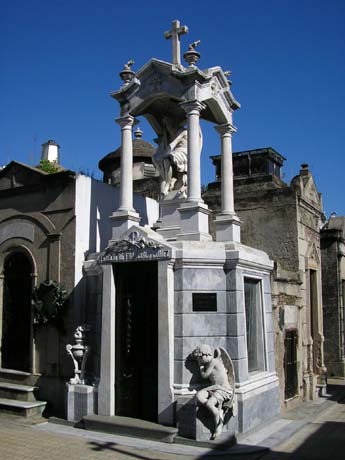 But Recoleta is not only a story of past power and glory. It is a place that is part of Buenos Aires everyday life. Cemetery custodians polish marble, cradle cats, chat on tomb steps and may open tomb doors for travelers who want to see an interior. (A tip is always welcome, but not mandatory.) Many tombs are lovingly personal, with interiors -- visible through windows or doors -- adorned with symbolic objects and mementoes: exquisite lace cloths over a coffin, a cross encrusted with gems. Behind one wrought-iron door there is a broken chair of carved wood and cane. Inside another there is a black and white photograph of a beautiful woman in a white feather boa.
Family, friends, admirers, patriots, visit faithfully. There's usually someone around, and the cemetery is especially busy on weekends. Visitors replenish flowers in vases, polish silver handles on coffins, leave messages, sit and reflect.
But Recoleta is not only a story of past power and glory. It is a place that is part of Buenos Aires everyday life. Cemetery custodians polish marble, cradle cats, chat on tomb steps and may open tomb doors for travelers who want to see an interior. (A tip is always welcome, but not mandatory.) Many tombs are lovingly personal, with interiors -- visible through windows or doors -- adorned with symbolic objects and mementoes: exquisite lace cloths over a coffin, a cross encrusted with gems. Behind one wrought-iron door there is a broken chair of carved wood and cane. Inside another there is a black and white photograph of a beautiful woman in a white feather boa.
Family, friends, admirers, patriots, visit faithfully. There's usually someone around, and the cemetery is especially busy on weekends. Visitors replenish flowers in vases, polish silver handles on coffins, leave messages, sit and reflect.
|
Reservations (Whatsapp enabled) in English, click on number below: Tel. +(54 911) 6566-5050 |